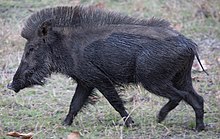TheIndian boar(Sus scrofa cristatus), also known as theMoupin pig,[2]is asubspeciesofwild boarnative to India, Nepal, Myanmar, western Thailand, Bangladesh and Sri Lanka.
| Indian boar | |
|---|---|

| |
| Indian boar,Bandhavgarh National Park,India | |
| Scientific classification | |
| Domain: | Eukaryota |
| Kingdom: | Animalia |
| Phylum: | Chordata |
| Class: | Mammalia |
| Order: | Artiodactyla |
| Family: | Suidae |
| Genus: | Sus |
| Species: | |
| Subspecies: | S. s. cristatus
|
| Trinomial name | |
| Sus scrofa cristatus Wagner, 1839
| |
| Synonyms[1] | |
|
Species synonymy
| |
The Indian boar differs from theCentral European Boarby its large mane which runs in a crest along its back from its head to lower body, larger, more sharply featured and straighter skull, its smaller, sharper ears and overall lighter build.[3]It is slightly taller and more sparsely haired than the European form, though its back bristles are much more developed.[2]The tail is also more tufted, and the cheeks hairier.[4]Adults measure from 84 to 91 cm (33 to 36 in) in shoulder height (with one specimen inWest Bengalhaving reached 97 cm (38 in)) and 152 cm (5 ft) in body length. Weight ranges from 91 to 136 kg (200 to 300 lb).[2]
The animal has interacted with humans in the Indian Subcontinent since theUpper Paleolithic,with the oldest depiction being a cave painting inBhimbetaka rock shelters,[5]and it occasionally appears inHindu mythology.A story present in theBrahmanassays thatIndrakilling a evil boar, who has stolen the treasure of theasuras,then giving its carcass toVishnu,who offers it as a sacrifice to the gods and goddesses and they eat it. In a story inCharaka Samhita,a boar named Ermusha is aavataraofBrahmaand he raises the earth and sky from the primeval waters of the universe during creation and creates the universe. In theRamayana,Mahabharataand thePuranas,another boar,Varahais anavatarof Vishnu that killsHiranyakshaand savesBhumi.[6]
See also
editReferences
edit- ^Wozencraft, W. C.(2005)."Order Carnivora".InWilson, D. E.;Reeder, D. M. (eds.).Mammal Species of the World: A Taxonomic and Geographic Reference(3rd ed.). Johns Hopkins University Press. pp. 532–628.ISBN978-0-8018-8221-0.OCLC62265494.
- ^abcLydekker, R. (1900),The great and small game of India, Burma, & Tibet,London: R. Ward, pp. 258-266
- ^Sterndale, R. A. (1884),Natural history of the Mammalia of India and Ceylon,Calcutta: Thacker, Spink, pp. 415-420
- ^Jerdon, T. C. (1874),The mammals of India; a natural history of all the animals known to inhabit continental India,London, J. Wheldon, pp. 241-244
- ^Mayer, John J., "Wild Pig Attacks on Humans" (2013). Wildlife Damage Management Conferences – Proceedings. Paper 151.http://digitalcommons.unl.edu/icwdm_wdmconfproc/151
- ^Macdonell, A. A. (1898),Vedic Mythology,Motilal Banarsidass Publ., p. 41
External links
edit- Media related toSus scrofa cristatusat Wikimedia Commons